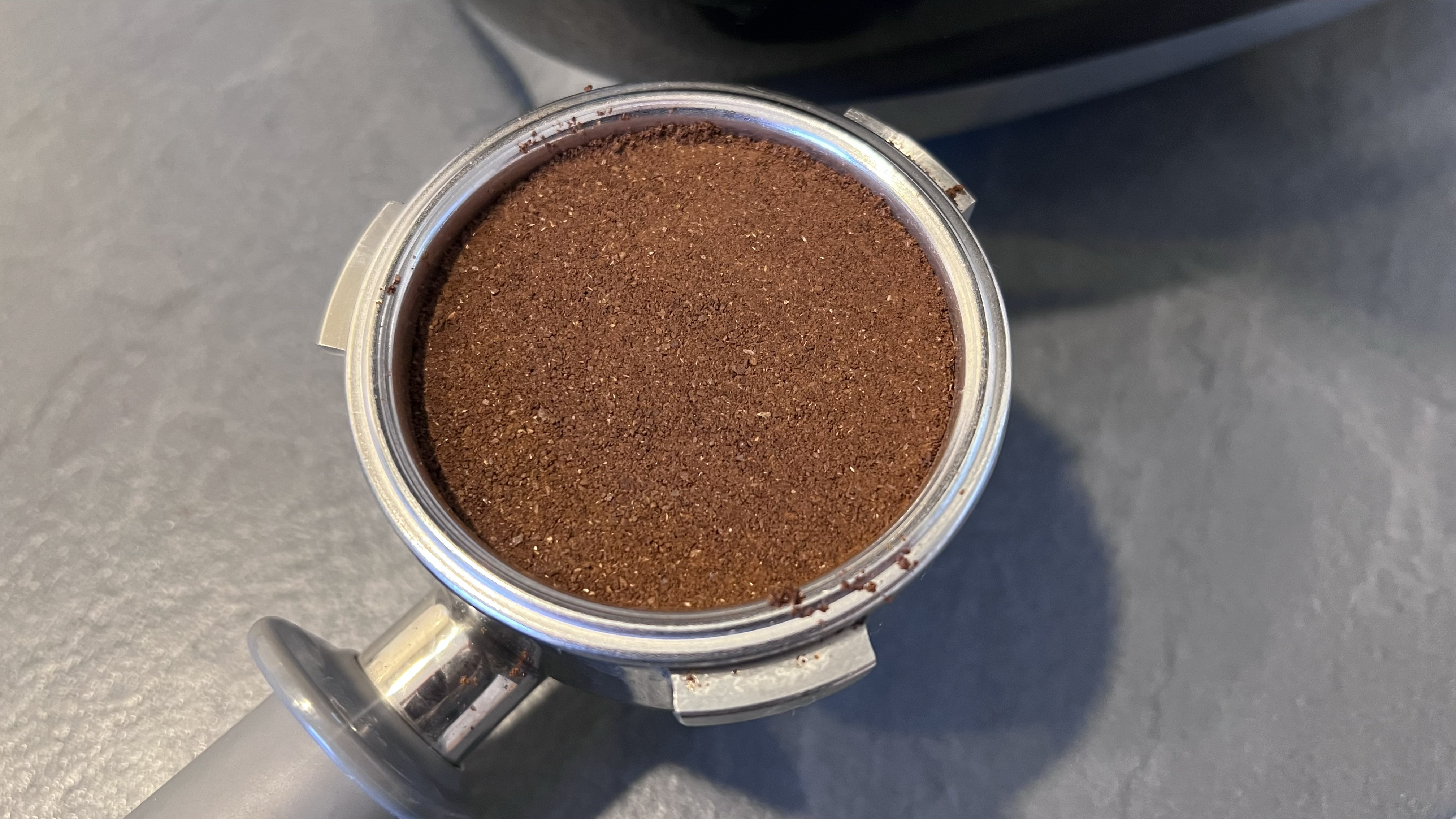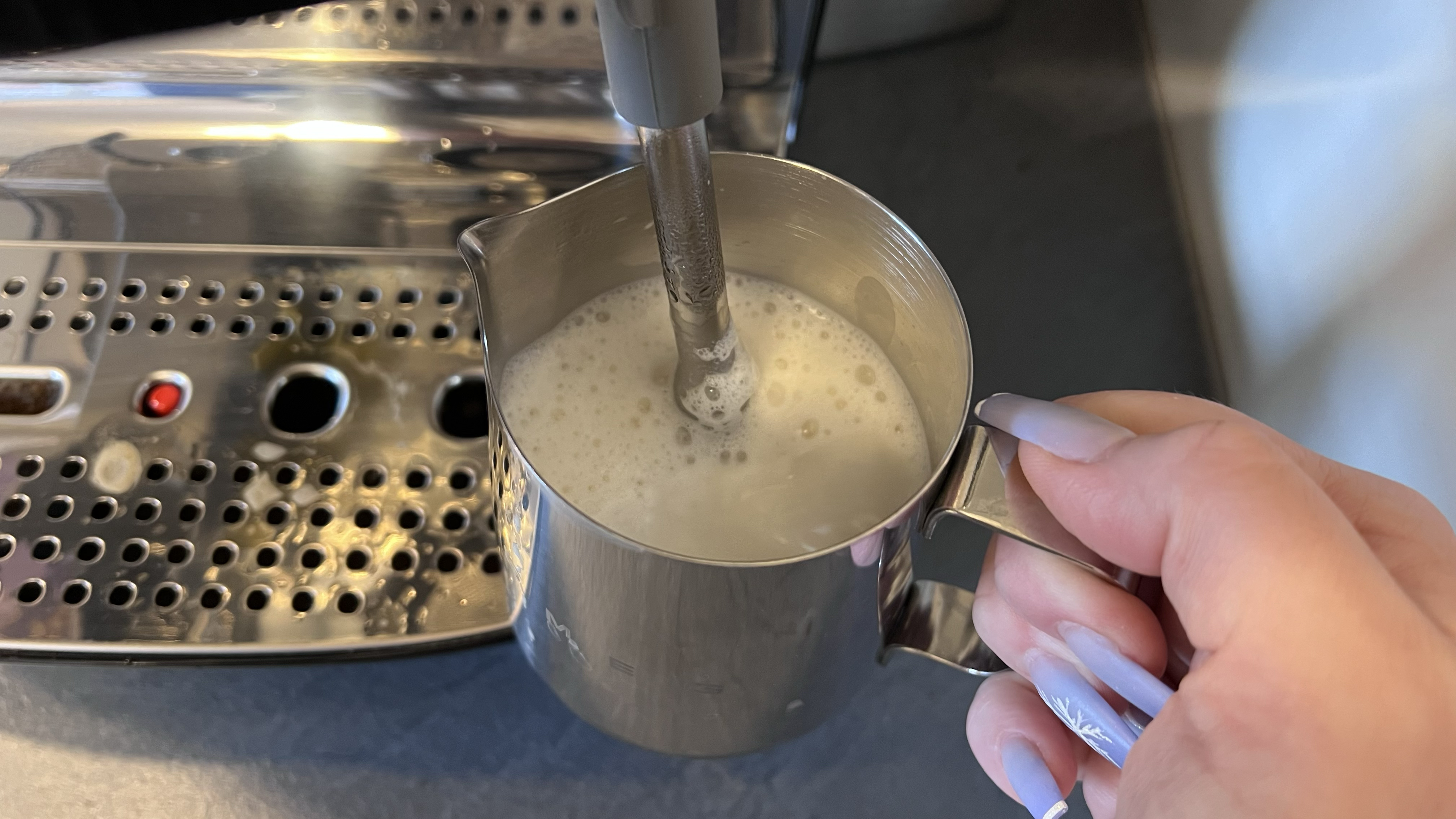How to make the perfect espresso shot: Elevate your coffee-making in 5 steps
Elevate your coffee-making with this step-by-step guide to pulling espresso shots

Whether you're a keen cappuccino drinker, an avid mocha fan, or just like your coffee as it comes, all barista-style drinks largely consist of two things – a shot of espresso and milk.
Of course, the way you prepare the milk and how much you add change the type of drink you end up with, but the espresso itself remains the same. The perfect espresso shot is key to the best-tasting and most robust coffee.
- Espresso machine: Our favorite espresso machine is the Breville Infuser BES840X.
– Portafilter: Most espresso machines have a portafilter and basket through which the coffee is filtered.
Tamper: A tamper is a weighted accessory used to 'tamp' the coffee, which is a fancy way of saying compacting and flattening the grounds. It also comes standard with most espresso machines.
- Grinder: Some espresso machines have built-in grinders, such as the De'Longhi La Specialista Arte Evo (Amazon) or the Smeg Espresso Manual Coffee Machine (review). Alternatively, you can buy standalone grinders like the Krups Precise Stainless Steel Flat Burr Grinder (Amazon). Conical burr grinders are widely accepted as the best type of grinder because of their high level of precision.
- Coffee beans: The best-tasting coffee comes from freshly ground beans. Alternatively, You can use coffee grounds but won't get the same full-rounded flavor.
- Scales (optional)
- Cup
"Coffee is possibly one of the most volatile products you’ve ever had the pleasure of working with," barista trainer Jon Skinner tells Top10Reviews. "It hates moisture, heat, light, and time, and they’re all on the move when making espresso." This can make the process seem daunting and difficult, but it doesn't need to be.
Understanding more about how the best espresso machines work and the process can improve your coffee-making skills and boost your confidence.
To help, I've run through each step below—from choosing and storing your beans to getting the perfect crema—and I get expert tips and advice from Jon, the UK's longest-established independent barista trainer.
Choosing coffee beans largely comes down to personal taste and budget. As does your choice of milk.
The only thing to bear in mind is how you store the beans. As Skinner explains: "Coffee can go stale, so it should be treated like bread. This means storing it in a dark, cool, dry place, never in the fridge." Moisture and temperature can interfere with the taste of the beans and cause them to become stale and lose flavor.
Sign up to receive the latest news, reviews, buying guides and deals direct to your inbox

Jon Skinner is the UK's longest-established independent Barista Trainer. After several years of working within catering, Jon Skinner moved towards offering professional barista training services, and over the years, has developed courses that are recognized by bodies such as The Speciality Coffee Association (SCA), Beverage Standards Association (BSA), and City & Guild.
How to pull the perfect espresso shot: Quick steps
- Prepare: Clean and dry your espresso machine and accessories
- Pre-heat: Preheating the machine brings the water to the optimal temperature.
- Grind: Grind your coffee beans and place the grounds in the portafilter.
- Tamp: Level off excess grounds and tamp to flatten and compress the grounds.
- Lock and pull: Lock the portafilter into the group head and extract the shot into a cup.
- Steam (optional): Steam and froth the milk. This step only applies if you're making a warm milk-based drink.
Reviews
Bosch TQU60703 800 Series VeroCafe Espresso Machine review: a smart coffee maker that can do it all
Casabrews 5700Pro Espresso Machine review: an all-in-one espresso machine with a learning curve
Jura E8 review: the best-selling bean-to-cup coffee maker from the brand
De'Longhi TrueBrew Drip Coffee Maker review: truly a marvelous brewing experience
De'Longhi Eletta Explore review: a bean-to-cup coffee maker with hot and cold brew options
L’OR Barista Coffee & Espresso System review: espresso shot or cup of coffee?
General rule
I go into more detail about these elements below but, as a general rule, the best conditions for making a great espresso shot are:
- 0.56 oz coffee grounds (16g)
- 25-second extraction time
- Water temperature between 195F and 205F (90C and 96C)
How to pull the perfect espresso shot: Step by step guide
1. Clean and pre-heat your machine

Before pulling your espresso shot, make sure your espresso machine, grinder, and accessories are clean and free from any old coffee residues or oils. This not only helps get the best flavor from the grounds, but it also extends the life of your equipment.
2. Pre-heat your machine

Next, preheat your machine. The first thing that can impact the flavor is the water temperature used to pull the shot. "If the temperature is too low, the espresso will taste weak," says Skinner. "If it's too high, you'll burn the coffee, which will be bitter."
The sweet spot is between 195F and 205F (90C and 96C), and within this range, the water temperature allows for a balance of acidity, sweetness, and bitterness. Many modern machines handle this step automatically and are set to deliver a temperature of 194F / 92C, but if you're manually heating the water, you'll need a thermometer or something similar.
3. Grind the beans

Getting the grind right is a skill in itself, and this is where the most experimentation (and frustration!) can occur. The size of the grind—from fine to coarse—plays a direct role in how much pressure is created and how quickly the water moves through the grounds, extracting the coffee. Both of these factors impact the flavor.
Choosing a high-quality grinder is a good place to start. "A domestic machine is only as good as the fineness of the grind you’re going to put into it," continues Skinner. "If you have a good-quality grinder, you’ll get closer to the perfect espresso."
Unfortunately, there is no easy or quick way to know how fine or coarse your grind needs to be. This is because there are many variables, from the type of beans you're using to the grinder, your basket, tamping pressure, and the number of coffee grounds used. To master the grind, you may need to pull a few shots and check their consistency and taste to find the best size.
Generally, you want to grind 16g of coffee per espresso shot, and the extraction should take 25 seconds. "We recommend a 25-second extraction time because only 26% of coffee is dissolvable," explains Skinner. "In the perfect extraction, the optimum amount of 18-22% of these solids can be effectively dissolved in 25 seconds when there is 16g of coffee."
Again, most modern domestic machines are set up to deliver the optimal amount automatically. Still, if you want to check or be ultra-precise, it's worth weighing the grounds before putting them in the portafilter basket.
4. Tamp

Once the coffee has been added to the portafilter, use the tamper to level off the excess grounds and flatten and compress them into the basket.
You don't need to press or compact the coffee too tightly. As Skinner says, "You just need to apply enough pressure until you feel the first signs of resistance."
5. Lock and pull

Once the grounds have been compressed, twist and lock the portafilter into the group head on the espresso machine. Place your cup underneath, select whether you want a single or double shot, and extract your coffee.
6. Steam

This step only applies if you're making a warm milk-based drink.
Pour the milk into a jug and, using the steam wand on your espresso machine, steam the milk until it’s hot. You can alternatively heat the milk in the microwave or on the stove.
"The human palette burns at 159 F / 71 C," says Skinner. "We train baristas to heat milk between 148-158 F / 65-70 C so you can drink it immediately. Milk then scalds at 180 F / 82 C, which ruins its taste."
To eliminate guesswork, I recommend buying a pitcher with a built-in temperature gauge, such as this $11.99 Milk Frother from Amazon.
If you're using the steam wand as a milk frother, move it up and down slowly in the milk to create small bubbles. This steam jet can be quite powerful, so you can alternatively use a standalone milk frother or small hand whisk, like the $16.99 Bean Envy Handheld Milk Frother at Amazon, to create small, fine bubbles.
FAQs
How do I know if my grind size is correct?
The best way to know if your grind size is correct is to keep experimenting until you find a taste and consistency you like. Ultimately, the perfect espresso is the one you like best.
That said, there are a few clues to look out for mid-pour that can help you refine the process.
- Pressure: While pulling your shot, check the pressure gauge on the front of many modern machines. If the dial rises but falls, there isn't enough pressure. There's too much pressure if it swings to the top of the bar. The dial should instead rise and stop within the optimum pressure bar usually found in the middle of the gauge.
- Size of the pour: The optimum extraction time should be 25 seconds. If you look at the pour and the tails of coffee coming out of the portafilter are too wide, it's extracting too fast. This means the grind is too coarse. If the coffee is dripping out, it's extracting too slowly, so the grind is too fine.
- Color of the pour: In a well-extracted espresso, the tails will start dark brown before lightening as the natural sugars dissolve. If the tails don't change color, and particularly if they're too light throughout, the espresso isn't right, and the grind will need changing.
- Crema: A well-extracted espresso will have a thick, brown crema on the top.
What is crema?
Crema is the creamy, caramel-colored layer of foam that sits on top of an espresso shot. It is created during the brewing process.
When hot water is forced through the coffee grounds, the heat and pressure emulsify the natural oils in the coffee and trap tiny air bubbles, creating a rich foam. The presence of crema indicates that the coffee beans are fresh and the espresso has been extracted properly.
The composition of crema includes tiny coffee particles, oils, and gases (like carbon dioxide). It adds to the overall flavor and aroma of the espresso, adding a slight bitterness and richness that balances the strong, concentrated coffee underneath.
The crema quality can be influenced by several factors, including the type of coffee bean, the roast level, the grind size, the beans' freshness, and the espresso machine's pressure and temperature.

Victoria Woollaston, with nearly 20 years of experience, has reviewed gadgets, beauty tech, and household appliances for WIRED, TechRadar, and Expert Reviews. She specializes in critiquing coffee makers and small appliances for Top Ten Reviews. Victoria is also the founder and editor of inclusive beauty and grooming sites mamabella and MBman.
